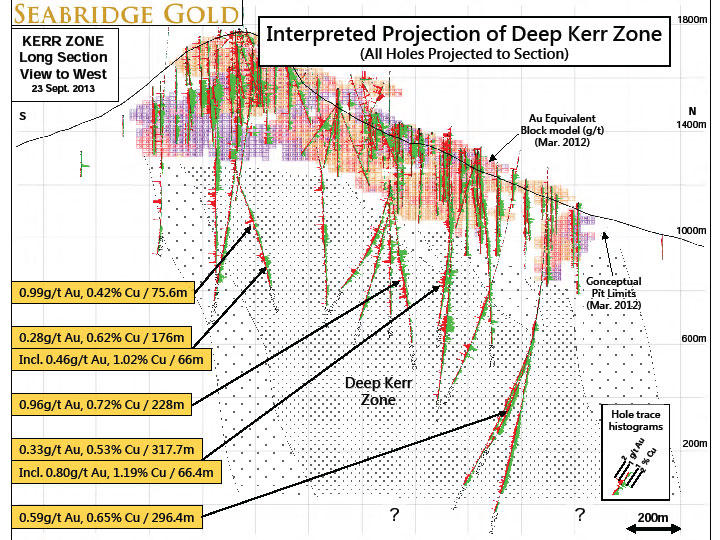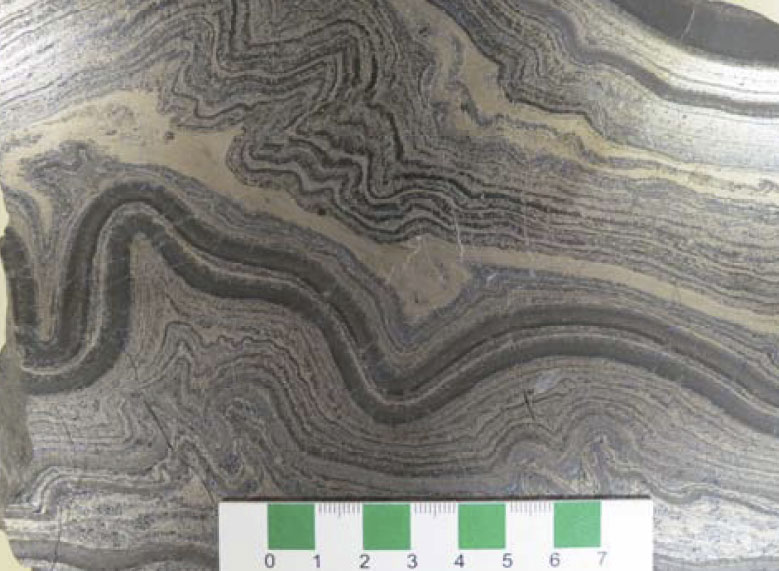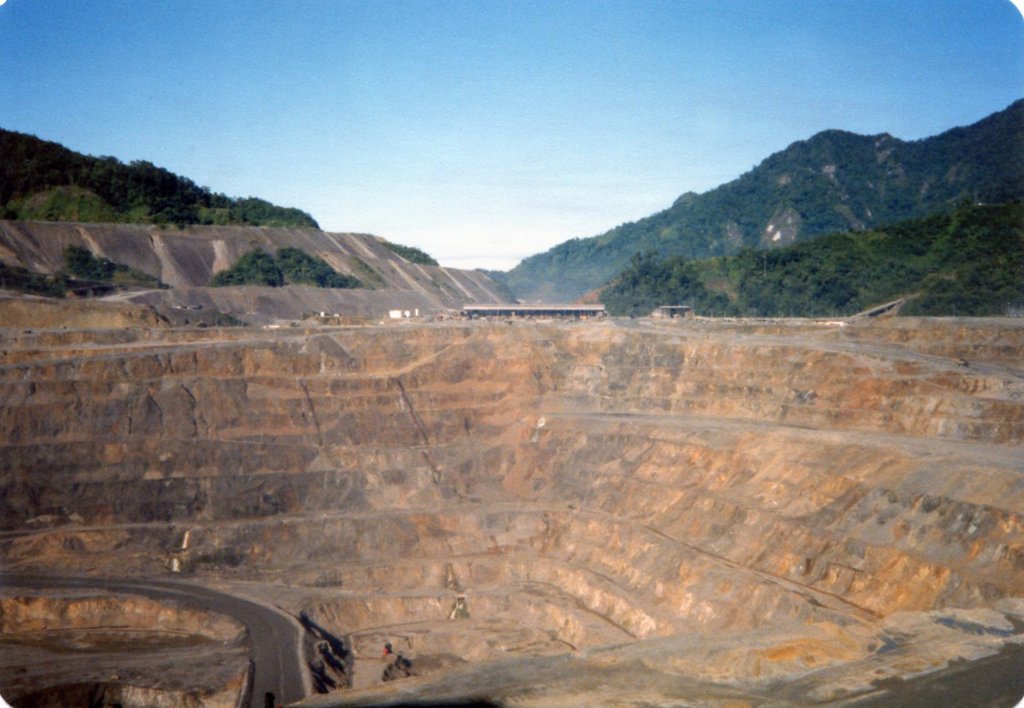Now the KSM is starting to look like a real copper porphyry system. Deep Kerr results show large intervals of respectable copper values and perhaps more importantly, gold grades that are holding steady.
[box type=”info” align=”aligncenter” ]Disclaimer: This is an editorial review of a public press release and may include opinions or points of view that may not be shared by the owners of geologyforinvestors.com or the companies mentioned in the release. The editorial comments are highlighted so as to be easily separated from the release text. Please view the full release here.[/box]
TORONTO, CANADA–(Marketwired – Sept. 24, 2013) – Seabridge Gold (TSX:SEA) (NYSE:SA) announced today that additional drilling of the Deep Kerr core zone continues to yield wide intercepts of higher grades on its 100% owned KSM project in north western British Columbia, Canada. Five diamond core drill rigs are now focusing on 1,000 meters of strike along the zone to generate data for an initial resource estimate. The Deep Kerr core zone measures at least 1,600 meters along strike and remains open to the north and at depth.
[box type=”note” align=”aligncenter” ]We’ve previously covered the KSM project. You can read more about it here. There have been a series of press release on “Depp Kerr” as of it late and it appears to be Seabridge’s primary focus.[/box]
Seabridge announced on August 12, 2013 a higher-grade copper-gold core zone named Deep Kerr was discovered beneath the Kerr porphyry deposit (see news release). On September 12, 2013, Seabridge further announced that it had discovered a bornite-rich zone within Deep Kerr with exceptional grades (see news release). Subsequent drilling has confirmed strong continuity of both the larger Deep Kerr zone and the very high grade bornite zone contained within it.
[box type=”note” align=”aligncenter” ]Copper Porphyry systems have been widely studied, and while every deposit is different, they do have some general similarities: Very large deposits of low grade copper (plus gold, silver, moly) usually shallow enough to be mined by open pit. The KSM deposit has always been a little bit puzzling in that it appeared to be a strongly hydrothermally altered remnant of copper porphyry system that concentrated the gold in small pods, sheets and veins – but not a traditional copper porphyry system.
In early 2012 Seabridge announced that it was planning some deeper drilling below their main zones since geophysical surveys indicated a low resistivity zone below the deposit, and drill results indicated the deposit to be open at depth. This sort of program can be a tough sell for project geologists. Drilling is never cheap and even the risk-loving juniors will shy away from expensive gambles.
Now the KSM is starting to look like a real copper porphyry system. Deep Kerr results show large intervals of respectable copper values and perhaps more importantly, gold grades that are holding steady.
[/box]
Assay results from the next four core holes drilled at Deep Kerr this year are:
| Hole ID | Total Depth (meters) | From (meters) |
To (meters) |
Thickness (meters) | Gold Grade (g/T) | Copper Grade (%) |
Silver Grade (g/T) |
|||||||
| K-13-23B | 1359 | 953.0 | 1249.4 | 296.4 | 0.59 | 0.65 | 1.1 | |||||||
| K-13-24C | 1284 | 825.0 | 1053.0 | 228.0 | 0.96 | 0.72 | 2.6 | |||||||
| K-13-25A | 883.6 | 959.2 | 75.6 | 0.99 | 0.42 | 2.7 | ||||||||
| 1337 including |
1158.4 1158.4 |
1334.4 1224.4 |
176.0 66.0 |
0.28 0.46 |
0.62 1.02 |
1.8 2.5 |
||||||||
| K-13-30 | 771 including |
326.0 524.2 |
645.7 590.6 |
317.7 66.4 |
0.33 0.80 |
0.53 1.19 |
1.0 1.7 |
2013 drilling at Deep Kerr is employing state-of-the-art directional drilling tools that enable additional holes to be started part way down a previously drilled hole. The directional tools ensure that the new hole deviates from the first in a predictable manner to provide multiple intersections of the target, off-set from the original intercept. This technology significantly reduces the amount of drilling required to achieve a new intercept of the target zone as the top 500 to 800 meters of the hole is not re-drilled. The above reported drill holes with a letter designation after the hole number represent wedged drill holes completed from holes that have been previously reported (i.e. K-13-23, K-13-24 and K-13-28). Drill hole K-13-23B wedged from K-13-23 at 535 meters. Hole K-13-24C was wedged at 500 meters from K-13-24, and K-13-25A was wedged from hole K-13-25 at 600 meters.
[box type=”note” align=”aligncenter” ]We’ve pulled one the the cross sections from the release and included it below. It shows the “fanning” out of the drill holes from the directional drilling. Copper grades are show in green and gold in red. Keep in mind that a cross-section is a 2D representation of results from one angle only. The extent of Deep Kerr zone is an interpretation by the project geologist based on what they know so far.[/box]

The above reported drill holes were designed to intersect mineralized zones as close as technically feasible to a perpendicular angle to their strike. Therefore, the true widths of this mineralization are believed to be 75% or greater of the reported intercepts. (For a drill location map and cross sections of Deep Kerr, see www.seabridgegold.net/DKmap3.pdf.
[box type=”note” align=”aligncenter” ]We keep repeating ourselves about true widths. Just a guess at this point, but not unreasonable.[/box]
The KSM Project contains one of the largest undeveloped gold and copper reserves in the world. Its composite intrusive complex hosts four large gold-copper porphyry deposits with direct genetic links to epithermal vein deposits including the neighboring Brucejack/Valley of the Kings development owned by Pretium Resources. The KSM mining district has undergone enormous deformation as the rocks that host its deposits were welded onto the North American continent. As a consequence of this deformation, many of the original geometric arrangements and mineralogical cues common in porphyry systems have been significantly modified and obscured. Seabridge is now unravelling the complex history of the district in order to discover the magmatic sources of its huge mineralizing systems.
Proven and probable reserves at KSM are as follows:
| Average Grades | Contained Metal | ||||||||||
| Project | Zone | Reserve Category |
Tonnes (millions) | Gold (gpt) | Copper (%) |
Silver (gpt) |
Moly (ppm) |
Gold (million ounces) |
Copper (million pounds) |
Silver (million ounces) |
Moly (million pounds) |
| KSM | Mitchell | Proven | 476 | 0.67 | 0.17 | 3.05 | 60.9 | 10.3 | 1,798 | 47 | 64 |
| Probable | 935 | 0.57 | 0.16 | 3.11 | 50.7 | 17.2 | 3,296 | 93 | 104 | ||
| Iron Cap | Probable | 193 | 0.45 | 0.20 | 5.32 | 21.5 | 2.8 | 834 | 33 | 9 | |
| Sulphurets | Probable | 318 | 0.59 | 0.22 | 0.79 | 50.6 | 6.0 | 1,535 | 8 | 35 | |
| Kerr | Probable | 242 | 0.24 | 0.45 | 1.2 | 0.0 | 1.9 | 2,425 | 9 | 0 | |
| KSM Totals | Proven | 476 | 0.67 | 0.17 | 3.05 | 60.9 | 10.3 | 1,798 | 47 | 64 | |
| Probable | 1,688 | 0.51 | 0.22 | 2.65 | 40.1 | 27.9 | 8,090 | 144 | 149 | ||
| Total | 2,164 | 0.55 | 0.21 | 2.74 | 44.7 | 38.2 | 9,888 | 191 | 213 | ||
Exploration activities at KSM are being conducted by Seabridge personnel under the supervision of William E. Threlkeld, Senior Vice President of Seabridge and a Qualified Person as defined by National Instrument 43-101. Mr. Threlkeld has reviewed and approved this news release. An ongoing and rigorous quality control/quality assurance protocol is being employed during the 2013 program including blank and reference standards in every batch of assays. Cross-check analyses are being conducted at a second external laboratory on 10% of the samples. Samples are being assayed using fire assay atomic adsorption methods for gold, total digestion ICP methods for other elements, and atomic adsorption methods for Cu, Ag, Mo, Pb, Zn and As on samples with >0.5% Cu, by ALS Minerals Canada Ltd. in North Vancouver, B.C.
[box type=”note” align=”aligncenter” ]We also keep repeating ourselves about QA/QC. No result should be taken seriously without a good quality assurance program.[/box]
Seabridge holds a 100% interest in several North American gold resource projects. The Company’s principal assets are the KSM property located near Stewart, British Columbia, Canada and the Courageous Lake gold project located in Canada’s Northwest Territories. For a breakdown of Seabridge’s mineral reserves and resources by project and category please visit the Company’s website at http://www.seabridgegold.net/resources.php.
[toggle title=”We’ve skipped some of the boilerplate. You can read it in here.” state=”close” ]
All reserve and resource estimates reported by the Corporation were calculated in accordance with the Canadian National Instrument 43-101 and the Canadian Institute of Mining and Metallurgy Classification system. These standards differ significantly from the requirements of the U.S. Securities and Exchange Commission. Mineral resources which are not mineral reserves do not have demonstrated economic viability.
This document contains “forward-looking information” within the meaning of Canadian securities legislation and “forward-looking statements” within the meaning of the United States Private Securities Litigation Reform Act of 1995. This information and these statements, referred to herein as “forward-looking statements” are made as of the date of this document. Forward-looking statements relate to future events or future performance and reflect current estimates, predictions, expectations or beliefs regarding future events and include, but are not limited to, statements with respect to: (i) the generation of data for a resource estimate for the deposit later this year; (ii) the proximity of the intercepts to true widths; (iii) the estimated amount and grade of mineral reserves and mineral resources; (iv) estimates of capital costs of constructing mine facilities and bringing a mine into production, including financing payback periods; (v) the amount of future production; and (vi) estimates of operating costs, net cash flow and economic returns from an operating mine. Any statements that express or involve discussions with respect to predictions, expectations, beliefs, plans, projections, objectives or future events or performance (often, but not always, using words or phrases such as “expects”, “anticipates”, “plans”, “projects”, “estimates”, “envisages”, “assumes”, “intends”, “strategy”, “goals”, “objectives” or variations thereof or stating that certain actions, events or results “may”, “could”, “would”, “might” or “will” be taken, occur or be achieved, or the negative of any of these terms and similar expressions) are not statements of historical fact and may be forward-looking statements.
All forward-looking statements are based on Seabridge’s or its consultants’ current beliefs as well as various assumptions made by them and information currently available to them. These assumptions include: (i) the presence of and continuity of metals at the Project at modeled grades; (ii) the capacities of various machinery and equipment; (iii) the availability of personnel, machinery and equipment at estimated prices; (iv) exchange rates; (v) metals sales prices; (vi) appropriate discount rates; (vii) tax rates and royalty rates applicable to the proposed mining operation; (viii) financing structure and costs; (ix) anticipated mining losses and dilution; (x) metallurgical performance; (xi) reasonable contingency requirements; (xii) success in realizing proposed operations; (xiii) receipt of regulatory approvals on acceptable terms, including the necessary right of way for the proposed tunnels; and (xiv) the negotiation of satisfactory terms with impacted Treaty and First Nations groups. Although management considers these assumptions to be reasonable based on information currently available to it, they may prove to be incorrect. Many forward-looking statements are made assuming the correctness of other forward looking statements, such as statements of net present value and internal rates of return, which are based on most of the other forward-looking statements and assumptions herein. The cost information is also prepared using current values, but the time for incurring the costs will be in the future and it is assumed costs will remain stable over the relevant period.
By their very nature, forward-looking statements involve inherent risks and uncertainties, both general and specific, and risks exist that estimates, forecasts, projections and other forward-looking statements will not be achieved or that assumptions do not reflect future experience. We caution readers not to place undue reliance on these forward-looking statements as a number of important factors could cause the actual outcomes to differ materially from the beliefs, plans, objectives, expectations, anticipations, estimates assumptions and intentions expressed in such forward-looking statements. These risk factors may be generally stated as the risk that the assumptions and estimates expressed above do not occur, but specifically include, without limitation: risks relating to variations in the mineral content within the material identified as mineral reserves or mineral resources from that predicted; variations in rates of recovery and extraction; developments in world metals markets; risks relating to fluctuations in the Canadian dollar relative to the US dollar; increases in the estimated capital and operating costs or unanticipated costs; difficulties attracting the necessary work force; increases in financing costs or adverse changes to the terms of available financing, if any; tax rates or royalties being greater than assumed; changes in development or mining plans due to changes in logistical, technical or other factors; changes in project parameters as plans continue to be refined; risks relating to receipt of regulatory approvals or settlement of an agreement with impacted First Nations groups; the effects of competition in the markets in which Seabridge operates; operational and infrastructure risks and the additional risks described in Seabridge’s Annual Information Form filed with SEDAR in Canada (available at www.sedar.com) for the year ended December 31, 2012 and in the Corporation’s Annual Report Form 40-F filed with the U.S. Securities and Exchange Commission on EDGAR (available atwww.sec.gov/edgar.shtml). Seabridge cautions that the foregoing list of factors that may affect future results is not exhaustive.
When relying on our forward-looking statements to make decisions with respect to Seabridge, investors and others should carefully consider the foregoing factors and other uncertainties and potential events. Seabridge does not undertake to update any forward-looking statement, whether written or oral, that may be made from time to time by Seabridge or on our behalf, except as required by law.
ON BEHALF OF THE BOARD
Rudi Fronk, Chairman and CEO
[/toggle]
[box type=”success” align=”aligncenter” ]Have a company or release you’d like us to look at? Let us know though our contact page, through Google+, Twitter or Facebook.[/box]






